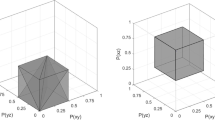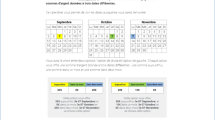Abstract
This paper explores how some widely studied classes of nonexpected utility models could be used in dynamic choice situations. A new "sequential consistency" condition is introduced for single-stage and multi-stage decision problems. Sequential consistency requires that if a decision maker has committed to a family of models (e.g., the multiple priors family, the rank-dependent family, or the betweenness family) then he use the same family throughout. Conditions are presented under which dynamic consistency, consequentialism, and sequential consistency can be simultaneously preserved for a nonexpected utility maximizer. An important class of applications concerns cases where the exact sequence of decisions and events, and thus the dynamic structure of the decision problem, is relevant to the decision maker. It is shown that for the multiple priors model, dynamic consistency, consequentialism, and sequential consistency can all be preserved. The result removes the argument that nonexpected utility models cannot be consistently used in dynamic choice situations. Rank-dependent and betweenness models can only be used in a restrictive manner, where deviation from expected utility is allowed in at most one stage.
Similar content being viewed by others
References
Allais, M. (1953). “Le Comportement de l'Homme Rationnel devant le Risque: Critique des Postulats et Axiomes de l'Ecole Américaine,” Econometrica21, 503-546.
Ben-Porath, E., I. Gilboa & D. Schmeidler. (1997). “On the Measurement of Inequality under Uncertainty,” Journal of Economic Theory75, 194-204.
Bernasconi, M. (1994). “Nonlinear Preference and Two-Stage Lotteries: Theories and Evidence,” The Economic Journal104, 54-70.
Chateauneuf, A. and P.P. Wakker. (1993). “From Local to Global Additive Representation,” Journal of Mathematical Economics22, 523-545.
Chew, S.H. (1983). “A Generalization of the Quasilinear Mean with Applications to the Measurement of Income Inequality and Decision Theory Resolving the Allais Paradox,” Econometrica51, 1065-1092.
Chew, S.H. (1989). “Axiomatic Utility Theories with the Betweenness Property,” Annals of Operations Research19, 273-298.
Chew, S.H. and L.G. Epstein. (1989). “The Structure of Preferences and Attitudes towards the Timing of the Resolution of Uncertainty,” International Economic Review30, 103-117.
Chew, S.H., L.G. Epstein, and P.P. Wakker. (1993). “A Unifying Approach to Axiomatic Non-Expected Utility Theories: Corrigenda,” Journal of Economic Theory59, 183-188.
Damme, E. van. (1983). “Refinements of the Nash Equilibrium Concept.” Springer, Berlin.
Dekel, E. (1986). “An Axiomatic Characterization of Preferences under Uncertainty: Weakening the Independence Axiom,” Journal of Economic Theory40, 304-318.
Eichberger, J. & S. Grant. (1997). “Dynamically Consistent Preferences with Quadratic Beliefs,” Journal of Risk and Uncertainty14, 189-207.
Eichberger, J. & D. Kelsey. (1996). “Uncertainty Aversion and Dynamic Consistency,” International Economic Review37, 625-640.
Elmes, S. and P.J. Reny. (1994). “On the Strategic Equivalence of Extensive Form Games,” Journal of Economic Theory62, 1-23.
Epstein, L.G. (1992). “Behavior under Risk: Recent Developments in Theory and Applications.” In J.J. Laffont (Ed.), Advances in Economic TheoryII, 1-63, Cambridge University Press, New York.
Epstein, L.G. and M. le Breton. (1993). “Dynamically Consistent Beliefs Must be Bayesian,” Journal of Economic Theory61, 1-22.
Epstein, L.G. and S.E. Zin. (1989). “Substitution, Risk Aversion, and the Temporal Behavior of Consumption and Asset Returns: A Theoretical Framework,” Econometrica57, 937-969.
Fishburn, P.C. (1988). “Nonlinear Preference and Utility Theory.” Johns Hopkins University Press, Baltimore, MD.
Gilboa, I. (1987). “Expected Utility with Purely Subjective Non-Additive Probabilities,” Journal of Mathematical Economics16, 65-88.
Gilboa, I. & D. Schmeidler. (1989). “Maxmin Expected Utility with a Non-Unique Prior,” Journal of Mathematical Economics18, 141-153.
Gorman, W.M. (1968). “The Structure of Utility Functions,”Review of Economic Studies35, 367-390.
Grant, S. (1995). “Subjective Probability without Eventwise Monotonicity: Or: How Machina's Mom May Also Be Probabilistically Sophisticated,” Econometrica63, 159-189.
Grant, S., Kajii, A., and Polak, B. (1998). “Intrinsic Preference for Information,” Journal of Economic Theory, forthcoming.
Grant, S., Kajii, A., and Polak, B. (1997). “Temporal Resolution of Uncertainty and Recursive Non-Expected Utility Models,” Working paper no 324, Dept. of Economics, Australian National University, Canberra, Australia.
Gul, F. (1991). “A Theory of Disappointment Aversion,” Econometrica59, 667-686.
Hammond, P.J. (1988). “Consequentialist Foundations for Expected Utility,” Theory and Decision25, 25-78.
Hazen, G.B. (1987). “Subjectively Weighted Linear Utility,” Theory and Decision23, 261-282.
Hurwicz, L. (1951). “Optimality Criteria for Decision Making under Ignorance,” Cowles Commission Discussion Paper, Statistics, No. 370, mimeographed.
Jaffray, J.Y. (1989). “Linear Utility Theory for Belief Functions,” Operations Research Letters8, 107-112.
Jaffray, J.Y. (1994). “Dynamic Decision Making with Belief Functions.” InR.R. Yager et al. (Eds), Advances in the Dempster-Shafer Theory of Evidence, 331-352, Wiley, New York.
Johnsen, T.H. & J.B. Donaldson. (1985). “The Structure of Intertemporal Preferences under Uncertainty and Time Consistent Plans,” Econometrica53, 1451-1458.
Kahneman, D. and A. Tversky. (1979). “Prospect Theory: An Analysis of Decision under Risk,” Econometrica47, 263-291.
Karni, E. and Z. Safra. (1990). “Behaviorally Consistent Optimal Stopping Rules,” Journal of Economic Theory51, 391-402.
Karni, E. and D. Schmeidler. (1990). “Utility Theory with Uncertainty.” InW. Hildenbrand and H. Sonnenschein (Eds.), Handbook of Mathematical Economics4, North-Holland, Amsterdam.
Klibanoff, P. (1995). “Dynamic Choice with Uncertainty Aversion,” Northwestern University.
Kohlberg, E. and J.F. Mertens. (1986). “On the Strategic Stability of Equilbria,” Econometrica54, 1003-1037.
Kreps, D.M. (1979). “A Representation Theorem for Preference for Flexibility,” Econometrica47, 565-577.
Kreps, D.M. (1990). “A Course in Microeconomic Theory.” Princeton University Press, Princeton, NJ.
Kreps, D.M. and E. Porteus. (1979). “Temporal Von Neumann-Morgenstern and Induced Preferences,” Journal of Economic Theory20, 81-109.
LaValle, I.H. (1992). “Small Worlds and Sure Things: Consequentialism by the Back Door.” InW. Edwards (Ed.), Utility Theories: Measurement and Applications. Kluwer Academic Publishers, Dordrecht, 109-136.
Lo, K.C. (1996). “Weighted and Quadratic Models of Choice under Uncertainty,” Economics Letters50, 381-386.
Luce, R.D. and P.C. Fishburn. (1991). “Rank-and Sign-Dependent Linear Utility Models for Finite First-Order Gambles,” Journal of Risk and Uncertainty4, 29-59.
Luce, R.D. and L. Narens. (1985). “Classification of Concatenation Measurement Structures According to Scale Type,” Journal of Mathematical Psychology29, 1-72.
Luce, R.D. and D. von Winterfeldt. (1994). “What common Ground Exists for Descriptive, Prescriptive and Normative Utility Theories,” Management Science40, 263-279.
Machina, M.J. (1989). “Dynamic Consistency and Non-Expected Utility Models of Choice under Uncertainty,” Journal of Economic Literature27, 1622-1688.
Machina, M.J. and D. Schmeidler. (1992). “A More Robust Definition of Subjective Probability,” Econometrica60, 745-780.
McClennen, E.F. (1990). “Rationality and Dynamic Choice: Foundational Explorations.” Cambridge University Press, Cambridge.
Quiggin, J. (1981). “Risk Perception and Risk Aversion among Australian Farmers,” Australian Journal of Agricultural Economics25, 160-169.
Sarin, R.K. (1992). “What Now for Generalized Utility Theory.” InW. Edwards (Ed.), Utility Theories: Measurement and Applications, 137-163, Kluwer Academic Publishers, Dordrecht.
Sarin, R.K. and P.P. Wakker. (1992). “A Simple Axiomatization of Nonadditive Expected Utility,” Econometrica60, 1255-1272.
Sarin, R.K. & P.P. Wakker. (1994). “Folding Back in Decision Tree Analysis,” Management Science40, 625-628.
Savage, L.J. (1954). “The Foundations of Statistics.” Wiley, New York. (Second edition 1972, Dover, New York.)
Schmeidler, D. (1989). “Subjective Probability and Expected Utility without Additivity,” Econometrica57, 571-587.
Segal, U. (1987). “The Ellsberg Paradox and Risk Aversion: An Anticipated Utility Approach,” International Economic Review28, 175-202.
Segal, U. (1990). “Two-Stage Lotteries without the Reduction Axiom,” Econometrica58, 349-377.
Selten, R. (1965). “Spieltheoretische Behandlung eines Oligopolmodells mit Nachfragetragheit,” Zeitschrift für die Gesamte Staatswissenschaft12, 301-324.
Starmer, C. and R. Sugden. (1991). “Does the Random-Lottery Incentive System Elicit True Preferences? An Experimental Investigation,” American Economic Review81, 971-978.
Strotz, R.H. (1956). “Myopia and Inconsistency in Dynamic Utility Maximization,” Review of Economic Studies23, 165-180.
Strotz, R.H. (1957). “The Empirical Implications of a Utility Tree,” Econometrica25, 269-280.
Tversky, A. & D. Kahneman. (1992). “Advances in Prospect Theory: Cumulative Representation of Uncertainty,” Journal of Risk and Uncertainty5, 297-323.
Wakker, P.P. (1989). “Additive Representations of Preferences, A New Foundation of Decision Analysis.” Kluwer Academic Publishers, Dordrecht.
Wakker, P.P. (1990). “Under Stochastic Dominance Choquet-Expected Utility and Anticipated Utility are Identical,” Theory and Decision29, 119-132.
Wakker, P.P. (1993). “Additive Representations on Rank-Ordered Sets II. The Topological Approach,” Journal of Mathematical Economics22, 1-26.
Wakker, P.P. (1996). “The Sure-Thing Principle and the Comonotonic Sure-Thing Principle: An Axiomatic Analysis,” Journal of Mathematical Economics25, 213-227.
Wald, A. (1950). “Statistical Decision Functions.” Wiley, New York.
Winkler, R.L. (1972). “An Introduction to Bayesian Inference and Decision Theory.” Holt, Rinehart and Winston, New York.
Author information
Authors and Affiliations
Rights and permissions
About this article
Cite this article
SARIN, R., WAKKER, P.P. Dynamic Choice and NonExpected Utility. Journal of Risk and Uncertainty 17, 87–120 (1998). https://doi.org/10.1023/A:1007769628257
Issue Date:
DOI: https://doi.org/10.1023/A:1007769628257




